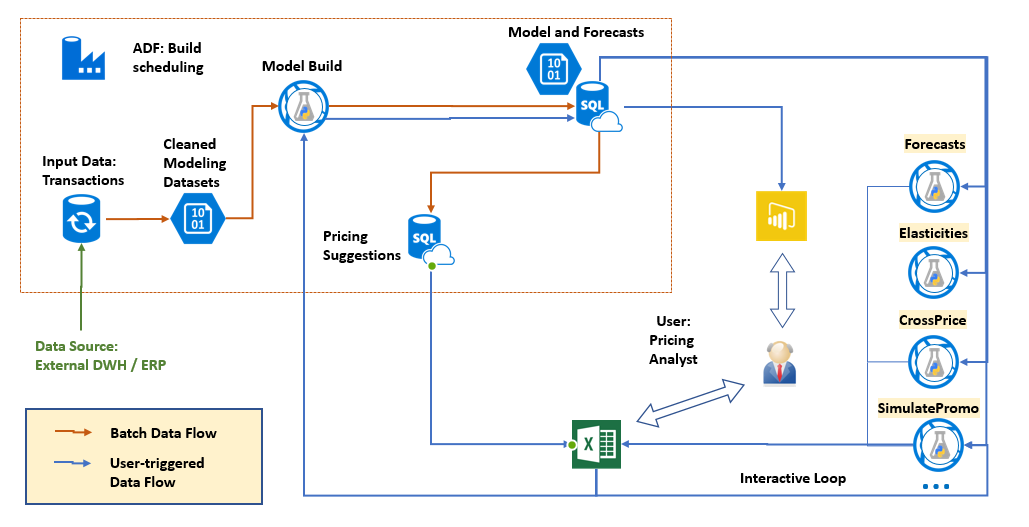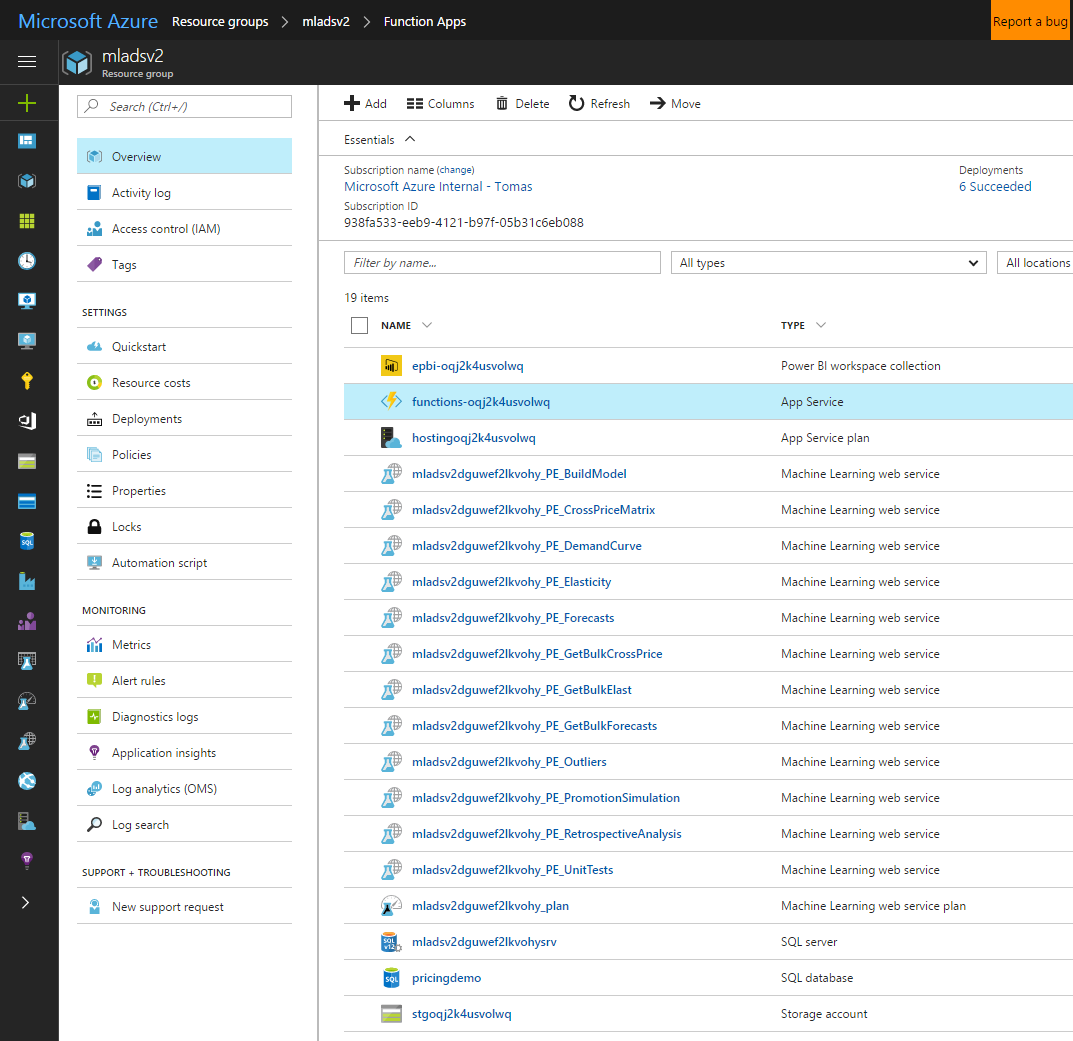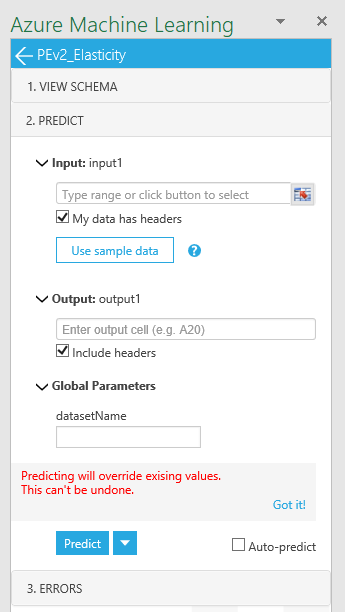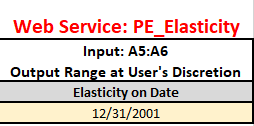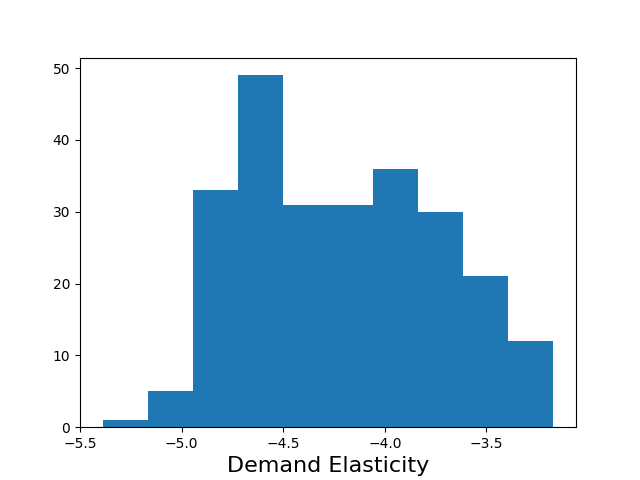28 KiB
Interactive Pricing Analytics Solution: Technical Deployment Guide
This document explains how to deploy the default configuration of the Interactive Pricing Analytics Solution. It is intended for technical personnel who will deploy the solution and connect it to the business data warehouse.
Outline
- Introduction
- Architecture
- Automated Deployment Workflow
- Connecting Your Data
- Customization
- Building Applications
- Troubleshooting
- Support and Feedback
Introduction
The Pricing Analytics Pre-Configured Solution (PCS) consists of a set of tools to help set prices for wholesale and retail products based on transaction records of past sales. It is made up of Azure Cloud and Microsoft Office components. The solution targets mid-size companies with small pricing teams who lack extensive data science support for complex pricing models and data flows.
This document explain technical details of the solution architecture, configuration and customization. The accompanying User Guide will help you understand the economic model and how the solution is intended to be used. We will describe how to modify the solution below.
Suitable and unsuitable applications
We recommend this solution where each customer segment faces the same posted price,typical of retail businesses. The data necessary doesn't need to track the
customer identity.
Conversely, the solution is unsuitable when the majority of transactions have prices negotiated for individual customers.
Architecture
The architecture can be summarized in the following diagram:
The solution architecture consists of the following Azure components:
- Azure SQL DB, used to store several different types of data, pre-process the transactional data for modeling, and generate pricing suggestions. A premium edition (P1) is recommended as the larger tables take advantage of clustered columnstore indices.
- Azure Storage account, used to save the model and intermediate data in Blobs.
- An AzureML web service for building models, running in batch mode.
- A collection of several interactive Azure ML services for querying the model. All services are created by turning the pricing engine package into a web service on the AzureML platform.
- A PowerBI dashboard, hosted in a Azure Web App
- Azure Data Factory for scheduling regular execution
Because every business system is different, the pre-configured solution does not include data flows from your business system to the SQL database, or the flow of pricing decisions back to business systems (e.g. ERP). An integration partner can connect these data paths for you.
Known limitations
The pre-configured solution necessarily makes some simplifying assumptions.
Some of the functional limitations are:
- We compute short-term elasticities only. In the short term, demand is less price-elastic than in the long term. For example, if a grocery store raises prices, customers will pay the higher price if the increment is small, rather than driving to another store: short term demand is relatively inelastic. But in the long run, customers may choose not to come to the more expensive store in the first place and demand will fall more.
- While the model internally works with arbitrary periods, the solution has a weekly periodicity baked into how the data is aggregated in pre-processing the ADF pipeline.
- The ADF pipeline works with one dataset only. To use with multiple datasets, we recommend you duplicate the solution. It will be more cost efficient, but more work to configure to duplicate and re-configure just the ADF activities and not the services or databases.
- We don't check any business rules, such as "the pick-up channel must be prices the same or lower as the delivery channel"
- Segmentation must be provided externally - we don't yet generate customer segments automatically.
In these cases the accuracy of the models will be limited:
- for the introduction of new products with little or no sales history,
- in scenarios where prices change due to anticipation of demand change by the seller that is not predictable from the data. For example, a decline in demand for a device when a new version is about to be released (Osborne effect). Seasonal variation seen in the data, on the other hand, is modeled, given sufficient history.
Automated Deployment Workflow
To start, you will need an Azure subscription to which you have resource creation permissions. A free trial subscription is sufficient for learning and experimenting with the solution.
To install the solution in your subscription, first go to the CIQS solution webpage and deploy the solution.
- The name you give your solution becomes a name for the resource group for tracking your resources and spending.
- Choose a location that is close geographically to your business users.
- Click Create.
The deployment goes through several provisioning and setup steps, using a combination of Azure Resource Manager (ARM) templates and Azure Functions. ARM templates are JSON files that define the resources you need to deploy for your solution. Azure Functions is a serverless compute service that enables you to run code on-demand without having to explicitly provision or manage infrastructure. We will describe ARM templates and Azure Functions used in this solution in later sections.
You will need to interact with the installer once, to create a user name and pasword for the database administrator account. Be sure to remember this password if you want to customize the solution! If you reset the database (e.g., in the Azure portal), Azure Data Factory will have trouble talking to the SQL server and the Linked Services will need an updated connection string with the new password.
Provisioned Azure Resources
Once the solution is deployed to the subscription, you can see the services deployed by clicking the resource group name on the final deployment screen.
The names of most of the resources will contain an illegible string (uniqueID) that makes them uniquely identifiable (which helps if you have multiple deployments). Please read [names in brackets] as variables. Let us explain in detail the purpose of each Azure resource.
The Power BI workspace ("epbi-[uniqueID]")
The Power BI workspace is a container to host your Power BI dashboards in the cloud. It is initially populated with the solution dashboard. Hosting your dashboards in a workspace enables embedding them in a Web App.
The Function App ("functions-[uniqueID]")
The Function App hosts Azure Functions; short tasks that are run after deployment, such as copying assets into the solution storage account, populating the database with the example dataset, and retrieving credentials for display in the final deployment page. The website which embeds the PowerBI workshop for display in the browser (pbijs and pbiweb) is also a Function App.
The Hosting Plan ("hosting[uniqueID]")
The hosting plan is a scaling and billing layer for the web applications.
The Machine Learning services ("[planname]PE[Servicename]")
The several machine learning services are the core logic of the solution. They generate the elasticity models and expose all of their aspects once they are created. The services themselves are stateless but communicate with state written in the storage account.
The Machine Learning Pricing Plan ("[planname]_plan")
The pricing plan is how all the machine learning services get billed. A new S1 pricing plan is created by default. All of the ML web services share this pricing plan.
The SQL server ("[planname]srv")
The SQL server hosts the SQL database. SQL servers are free in Azure, usage is billed at database level, depending on the selected performance tier.
The SQL database ("pricingdemo")
The database is the main data interface between the solution and the surrounding computing environment, hosting all the structured datasets as tables. It also performs some bulk compute tasks, such as optimal price suggestion. A new S1 database is provisioned by default.
The storage account (stg[uniqueID])
The storage account acts most importantly as the storage layer for the pricing engine models. It also holds the weekly run outputs from the machine learning services. We provision a new LRS account and recommend that you turn the encryption on after deployment.
One-time workbook setup
After the solution is deployed, you will see a basic graphical overview in the Power BI dashboard. To get numeric outputs, you will need configure an Excel template for interacting with the solution. Download the template and open it. The Excel workbook has multiple tabs, each corresponding to a task in pricing analysis.
Configuration requires connecting the appropriate web services to the workbook. Please connect these services by pasting their request-response URL into the AzureML plugin. The URLs and keys are displayed at the final CIQS page, which you can access from the Deployments section of CIQS. You can also see all of your services here.
Detailed connection instructions are found in the workbook, on the "Instructions" tab. After adding the services, save the Excel workbook under an appropriate name; we use AnalysisTemplate.xsls and share it with users in your organization. This configured workbook template will be used to receive data output from the analytical pipeline.
Step-By-Step Visual Studio Deployment
For modification of the solution, it is possible to deploy the elements of the solution with a few clicks from their Visual Studio solution files, using Cloud Explorer. The advantage of this method is that you have source control of any modification you are making to the solution, as is appropriate for developers and integrators. It requires the full solution source code. If you are a Microsoft partner, please contact us to arrange access.
Connecting Your Data
Analytics is only useful to you if it runs on your data. This section describes the inputs and output datasets of the solution.
Input dataset
The main prerequisite is sales history data. The solution expects sales history data in the table dbo.pricingdata, with the folllowing schema:
CREATE TABLE dbo.pricingdata (
SalesDate date not null,
Item varchar(100) not null,
SiteName varchar(100) not null,
ChannelName varchar(100) not null,
ItemHierarchy varchar(500) not null,
UnitPrice float not null,
UnitCost float null,
Quantity float not null,
CustomerSegment varchar(100) not null
)
The solution defines the data as an external ADF dataset, which means the data is expected to be present in this table. It is the integrator's responsibility to ensure that it does. We recommend that you use Azure Data Factory or SSIS to push sales data incrementally from your business data warehouse to this table. While preparing the data, please consider the following points:
- Data can be aggregated weekly or left in the original one-row-per-transaction state, in which case the system will be aggregate it to weekly quantities.
- If you aggregate the transactions, we recommend against defining the price as a weekly average of prices. Instead, we recommend you group by distinct discrete prices if possible.
- ItemHierarchy must be provided as a comma-separated list of categories, highest level first, for example "Cosmetics, Soap, Coconut Soap". If your items are not organized in a product hierarchy, use a single string like "Products".
- SiteName, ChannelName, CustomerSegment also must be provided, if your data does not break down along these dimensions, use "All" or a similar constant as well.
Output datasets
These four SQL tables are the output tables of the solution. You can expect them to be populated weekly. They underlie the Solution dashboard and can be used to create other visuals as well.
- Elasticities
- Cross-elasticities
- Forecasts
- SuggestionRuns
Common columns and conventions
Outputs from the current run are appended to these tables.
Each table has a RunDate column, corresponding to the date on which the data was appended. The RelationValidDate column refers to the time for which the value of elasticity or demand was measured. For example, one might run the model on Jun 30, 2017 and obtain estimates for all times in the history. Then Rundate ='2017-06-30' and there will be a number of RelationValidDates, one for each historical period.
All tables have columns named Item, SiteName, ChannelName, and CustomerSegment, identifying the specific individually priced SKU for which the estimate or prediction is given.
Where there appear columns named <Measure>90LB and <Measure>90UB, they indicate the 90-percent confidence interval around the estimate.
Elasticities dataset
CREATE TABLE dbo.Elasticities (
RunDate date not null,
RelationValidDate date null,
Item varchar(100) not null,
SiteName varchar(100) not null,
ChannelName varchar(100) not null,
CustomerSegment varchar(100) not null,
Elasticity float not null,
Elasticity90LB float not null,
Elasticity90UB float not null,
)
Cross-Elasticities dataset
The Cross-Elasticities table stores all the cross-elasticities that were estimated.
CREATE TABLE dbo.CrossElasticities (
RunDate date not null,
RelationValidDate date null,
CustomerSegment varchar(100) not null,
DrivingItemKey varchar(100) not null,
DrivingSiteName varchar(100) not null,
DrivingChannelName varchar(100) not null,
ImpactedItemKey varchar(100) not null,
ImpactedSiteName varchar(100) not null,
ImpactedChannelName varchar(100) not null,
CrossElasticity float not null,
)
There are two sets of items, prefixed with Driving and Impacted, since cross-elasticity is an asymmetric relation. The estimated value is in the CrossElasticity column.
Forecasts dataset
The Forecasts table stores all the forecasts the model has made. RunDate doubles as an identifier of the forecast run.
CREATE TABLE dbo.Forecasts (
RunDate date not null,
Source varchar(100) not null, -- where did the forecast come from?
Item varchar(100) not null,
SiteName varchar(100) not null,
ChannelName varchar(100) not null,
CustomerSegment varchar(100) not null,
LastDayOfData date not null, -- forecast made using data up and including this
PeriodInDays int not null,
PeriodsAhead int not null,
ForecastPeriodStart date not null,
ForecastPeriodEnd date not null, -- end of the period whose demand is forecasted
UnitPrice float, -- forecast is conditional on this price.
Demand float not null,
Demand90LB float not null,
Demand90UB float not null,
ActualSales float null,
sAPE float null,
qBar float null
primary key (RunDate, Item, SiteName, ChannelName,
LastDayOfData, ForecastPeriodStart, ForecastPeriodEnd)
)
- LastDayOfData is the last day of data available at the time that this forecast is made.
- PeriodInDays makes it clear how many days there are in the forecast period.
- PeriodsAhead is how many periods ahead we are forecasting.
- ForecastPeriodStart and ForecastPeriodEnd denote the date range in which the predicted Demand is to be realized.
The estimate is in the Demand column. If the forecast is made for a period in the past, the ActualSales are known, and the Symmetric Average Percentage Error (sAPE) is calculated. To put the sAPE in perspective, the qBar is a smoothed-measure demand around the forecast period.
Suggestions dataset
The SuggestionRuns table stores the pricing suggestions made from the elasticities and forecasts.
CREATE TABLE [dbo].[SuggestionRuns] (
[suggestionRunID] VARCHAR (200) NOT NULL,
[pastPeriodStart] DATE NOT NULL,
[pastPeriodEnd] DATE NOT NULL,
[suggestionPeriodStart] DATE NOT NULL,
[suggestionPeriodEnd] DATE NOT NULL,
[minOrders] FLOAT (53) NOT NULL,
[Item] VARCHAR (100) NOT NULL,
[SiteName] VARCHAR (100) NOT NULL,
[ChannelName] VARCHAR (100) NOT NULL,
[CustomerSegment] VARCHAR (100) NOT NULL,
[UnitsLastPeriod] FLOAT (53) NULL,
[avgSaleUnitPrice] FLOAT (53) NULL,
[avgCostUnitPrice] FLOAT (53) NULL,
[Orders] INT NULL,
[RevenueLastPeriod] FLOAT (53) NULL,
[MarginLastPeriod] FLOAT (53) NULL,
[Elasticity] FLOAT (53) NOT NULL,
[marginOptimalPrice] FLOAT (53) NULL,
[marginOptimalPriceRounded] FLOAT (53) NULL,
[percentChange] FLOAT (53) NULL,
[forecastedDemandAtOptimum] FLOAT (53) NULL,
[forecastedDemandAtRounded] FLOAT (53) NULL,
[forecastedRevenueAtRounded] FLOAT (53) NULL,
[forecastedMarginAtRounded] FLOAT (53) NULL,
[incrementalMargin] FLOAT (53) NULL
);
The suggestionRunID is an identifier referring to the date of the model build version from which the suggestion are created.
- PastPeriodStart and PastPeriodEnd describe the time interval for which the baseline numbers (Orders, Revenue, Margin) are taken (the "past period").
- SuggestionPeriodStar and SuggestionPeriodEnd describe the period for which the price is proposed (the "suggestion period").
- minOrders is the minimum number of orders that need to have occured for the item in the past period to be considered in the suggestion pipeline.
Then we have the baseline numbers: UnitsLastPeriod, avgSaleUnitPrice, avgCostUnitPrice, RevenueLastPeriod, MarginLastPeriod whose interpretations are hopefully clear. Orders will be more than 1 only if disaggregated data are entered.
- Elasticity comes from the model estimatuon step, and the optimal prices follow from it and the marginal cost (avgCostUnitPrice). The exact price maximizing the gross profit margin is marginOptimalPrice, which is then rounded to "x.y9". The model predicts that it should be possible to make additional incrementalMargin dollars over the suggestion period.
Configuration
To set the parameters, update the table dbo.Parameters in the Solution's SQL database, which stores simple key-value pairs:
CREATE TABLE [dbo].[Parameters] (
[paramName] VARCHAR(50) NOT NULL,
[paramValue] VARCHAR(MAX) NULL,
PRIMARY KEY ([paramName])
)
The bulk services are the only ML Services running in the ADF pipeline and therefore need configuration.
Recognized parameters for bulk services
| Parameter (paramName) | Meaning | Default paramValue |
|---|---|---|
| BulkElasticities_DeltaX | Elasticity for what change in price*? | -0.1 |
| BulkElasticities_WeekJump | Retrieve elasticity for every n-th week | 1 |
| BulkForecasts_periodsAhead | Forecasts for many periods ahead? | 1 |
| BulkCrossPrice_WeekJump | Retrieve elasticity for every n-th week | 1 |
Adjusting suggestion lead times
In the current version you can adjust the lead times on suggestion by manipulating the date parameters which Azure Data Factory passes to the spRecommendProducts stored procedure Activity (see ADF description below). If you would like multiple suggestion periods, please duplicate the stored procedure activity and call it with different parameters.
"typeProperties": {
"storedProcedureName": "spRecommendProducts",
"storedProcedureParameters": {
"SliceEnd": "$$Text.Format('{0:yyyy-MM-dd}', SliceEnd)",
"lastDayOfData": "$$Text.Format('{0:yyyy-MM-dd}', SliceEnd)",
"suggestionPeriodStart": "$$Text.Format('{0:yyyy-MM-dd}', Date.AddDays(SliceEnd,1))",
"suggestionPeriodEnd": "$$Text.Format('{0:yyyy-MM-dd}', Date.AddDays(SliceEnd,7))",
"minOrders": "1"
}
Building Applications
While many users find the Excel environment natural, many will also require features that are not directly supported by our core models and pipelines. BI Applications will necessitate ETL jobs sending the data to other applications.
First, we will address the case of integrating the services into an application. Whether you are building a customer-specific user interface in Excel or another application, you will want to call the web services. We first give an detailed example of calling the Elasticity web service from Excel and describe its inputs and outputs. The other services operate analogously.
Then we will describe the ADF pipeline and the datasets in the storage account; it should help you consume the output in custom BI applications.
For customizing the AzureML services, please contact us directly.
Excel Example: Elasticity Service
You can inspect the elasticities of every product by navigating to the "Elasticities" tab of the Excel template and opening the "Elasticity" service pane of the AzureML plugin.
Because elasticities can change in time, a query date is required in cell A6 of the spreadsheet. We recommend using the date of the most recent model. The A5:A6 range of cells is the input to the service.
The output location should be set to a convenient location in the spreadsheet, e.g. Elasticities$A20. The "datasetName" parameter is 'latestModelBuild', where data refers to the day on which the model was created, using data available up to that day. You can explore previous models as wel.
The output consists of a dataframe containing the estimated elasticity of every Item at every Site, as well as the 90% confidence interval for the estimate. The range of elasticities can be seen in one glance by clicking on the generated external figure link containing the elasticity histogram.
To build customer analyses in Excel, you can use the output values in Excel calculations just like any value. Look in the Promotion Simulation tab for a simple example of building a dynamically updated chart from the output values.
To get the service to behave as if it was a first-order Excel function and update values in its output cells every time the input changes, check the Auto-predict box.
Calling REST APIs from anywhere
The services are simply AzureML RESTful APIs. You can go to your AzureML services link to grab sample code to consume them from R, Python, or C#.
See the Swagger documentation to the services to understand their input and output requirements. The same information is reflected in the VIEW SCHEMA pane of the AzureML plugin.
Individual Services Descriptions
There are three types of ML services in this solution: batch model build, interactive retrieval and bulk retrieval services.
The batch model build service is BuildModel and is responsible for all estimation and forecasting tasks. Depending on data size, it can run for several minutes to hours.
The interactive services are:
- Elasticities - retrieve elasticities for one product at all sites, channels, and segments.
- CrossElasticities - retrieve cross-elasticities for all products and channels at one site. The model assumes the same items at different sites don't compete. Perhaps more questionably, it also assumes that customer segmentation boundaries are not permeable.
- Forecasts - retrieve forecasts at one site, at a specific pricing point.
- PromoSimulation - simulate a promotional scenario.
- Outliers - identify the items which had large forecast failures.
- RetrospectiveAnalysis - assists
The service names may have a PE_ prefix (for "Pricing Engine"). These services are expected to return within a few seconds (The first query after a while may be slow as the containers "warm up"). All services have usage instructions in the template spreadsheet.
The bulk services are used to export the data from the model to the database. They output large amounts of data. In the solution, they are called in batch mode and their output stored in the database after output to the storage account. Each service produces one dataset.
- BulkElasticities - get all estimated elasticities, outputs to the elasticity container
- BulkCrossElasticities - get all estimated elasticities, outputs to the crosselasticity container
- BulkForecasts - get all estimated elasticities, outputs to the forecasts container
ADF structure
The Azure Data Factory has three Pipelines:
- Configure Services Pipeline creates small datasets containing solution parameters.
- Pricing Pipeline This is the large modeling pipeline which
-
- Prepares the data for modeling,
- Runs the models,
- Extracts forecasts and elasticities from the model, and
- Loads the model outputs into the database for visualization.
- Suggestions Pipeline creates pricing suggestions based on outputs of the Pricing pipeline.
You can view your pipelines in the Azure portal.
Storage account structure
The storage account has the following important folders:
- crosselasticity - extracted from the model in Pricing Pipeline
- elasticity - extracted from the model in Pricing Pipeline
- experimentoutput - AzureML experiment internal cache
- forecasts - extracted from the model in Pricing Pipeline
- originaldata - cleaned, processed input data at start of Pricing Pipeline
- pricing - contains the log files from model runs
- serviceparameters - parameter datasets produced by the Configure Services pipeline
Troubleshooting
Most of the trouble we experienced has to do with the demanding of scaling up. The solution is deployed with minimal Azure performance and cost levels, and larger datasets may need to use higher tiers of the resources.
"Blob does not exist" errors
The blob name is created from the datasetName given in the spreadsheet. Open the storage account and make sure a model with the given datasetName exists. The name is case-sensitive. The default datasetName used by ADF is "latestDemoBuild".
Timeouts on the BuildModel service
Try increasing the timeout period in the retrain_AzureML_Model ADF activity.
Database or dashboard slow
If you are experiencing performance issues with the database, try using a Premium database instead. Since the dashboard is direct-query, performance issues with the dashboard are often also database throughput issues.
FAQ
This section will be updated with common questions we get from implementing parties.
Support and feedback
Please contact Tomas.Singliar@microsoft.com with questions, requests or concerns about the solution.
